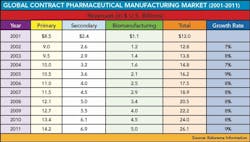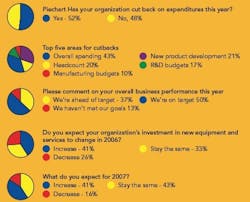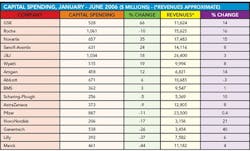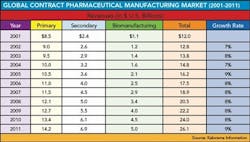THIS YEAR SAW some wrenching changes in the drug industry, as several leading name-brand drugs came off patent, and competitive pressures forced Merck, Pfizer and Schering-Plough to sell or shut down facilities, eliminating hundreds of jobs.
This isn’t the likeliest backdrop for expansion. In a survey on overall market conditions, readers were divided about prospects for this and next year (see Figure 1, below).
Mid-year financial reports suggest that most drug companies will spend more on plants, equipment and services this year, with the largest manufacturers likely to spend an average of $1 billion or more, globally. Within North America, spending is projected to increase by 11%, to $13.2 billion, driven by a few large-scale projects, according to Annette Krueger, pharma and biotech analyst for Industrial Info. Resources (Sugar Land, Texas).
Overall growth may not be dramatic, but most capital spending budgets are increasing (see Table 1, below) and outsourcing is becoming a more prominent part of many pharma companies’ plans.
“Pharma’s been talking about cutting back on spending for the last few years,” says Michael Zbinovec, director of corporate finance at Fitch Ratings (Chicago), who specializes in health care. “Any time you have fewer facilities, you have less spending.” As part of his research, Zbinovec talks to a large number of equipment suppliers. This year, he says, more pharma spending appears to be covering outsourcing, rather than new equipment purchases.
“Big pharma companies are engaged in huge cost-saving initiatives over the next two to three years,” says Vicki Tauscher Phelan, life sciences practice lead at Houston, Texas-based outsourcing consultancy EquaTerra.
Pfizer, for example, launched “Adapting to Scale,” designed to save $4 billion by 2008. Trimming procurement costs, and rationalizing suppliers, is a key part of the initiative, which was introduced last year. Between 2003 and 2008, the company expects to have reduced the number of its manufacturing plants by 25%.
Merck & Co., Inc. (Whitehouse Station, N.J.) also launched a massive restructuring program last year. The company projects overall savings of roughly $4 billion pretax over the next four years, and a $1.2 billion cut in overall purchasing. Merck expects to spend $1.3 billion ($100 million less than it did last year) on plant and equipment this year.
“The big pharma companies have to take a much different look at their businesses than they did 10 years ago,” says Bob Majczan, senior client partner at Korn/Ferry (Los Angeles). “Manufacturing wasn’t a real consideration then because the cost of goods was so small. The issue was availability. Now the financials are much more challenging,” he says.
As a result, Lean and manufacturing excellence programs appear to be shaping more spending plans. “There’s been a culture shift,” notes one anonymous respondent to our survey. “We see reduced spending across the entire organization, to reduce burn and to increase efficiencies with Lean.”
Room for Improvement
Yet, there appears to be room for improvement in the way that pharma companies manage capital projects. Says one consultant, who asks to remain anonymous, “At many drug companies, and all of large pharma, financial effectiveness still isn’t a focus. As a result, $50 million projects often end up costing two or three times that much.”
Flexibility is essential, and the impact of potential market changes should be considered during the pre-engineering stage of any project. “All too often, decisions are deemed absolutely necessary, but wind up making commercial success extremely difficult if market conditions change,” the unnamed consultant says.
Nevertheless, certain patterns have emerged this year: Spending on IT continues to be strong. Frank Scavo, president of Computer Economics, Inc. (Irvine, Calif.) says that pharma and medical device firms will spend roughly 2% of revenues on IT this year, nearly 6% more than they did in 2005. Next year, growth will dampen to 1%, he says.
| Top investment priorities for 2007 | |
| Manufacturing-scale process equipment |
27% |
| Facility design and construction |
9% |
| Packaging equipment |
15% |
| New IT systems |
12% |
| Building and facilities-related equipment |
10% |
| Pilot-scale equipment |
9% |
| QA products and methodologies |
8% |
| Compliance and validation |
6% |
| Traceability |
6% |
| Aseptic manufacturing equipment |
4% |
| “Important” investment priorities for 2007 | |
| Compliance and validation |
45% |
| QA products and methodologies |
33% |
| Manufacturing-scale equipment |
31% |
| Pilot-scale equipment |
30% |
| New IT systems |
7% |
| Aseptic manufacturing equipment |
26% |
| Facility design and construction |
23% |
| Outsourcing |
20% |
Automation needs are also driving spending, particularly for analyzers, says Dan Hebert, senior technical editor for Putman Media’s Automation Group. For the AutomationXchange program, Hebert recently interviewed a broad spectrum of pharma engineering managers to assess their capital investment needs and plans. “Users want to buy an analyzer like they buy a pressure transmitter — something that’s cheap, reliable and easy to install and maintain,” he observes.
Linking the plant floor to the executive suite is another recurring capital spending theme, Hebert says. “Their bosses don’t want to find that they spent millions to reautomate accounts payable with SAP and Oracle, when they thought they were going to get real-time access to production data,” he remarks.
“No one has staff, but everyone has projects,” which is a boon for systems integrators and engineering service companies, according to Hebert. “Vendors want to play here, but most end users see them as expensive and biased.”
Biopharma a Top Priority
Biopharmaceutical companies are among the most aggressive spenders. Amgen, for example, expects to spend over $1 billion this year on projects ranging from an enterprise resource planning (ERP) software implementation to an expansion of its bulk manufacturing, formulation, fill and finish capacity in Puerto Rico. The company also is beginning engineering and construction of a new process development, bulk manufacturing and formulation, fill and finish facility in Ireland. In addition, Amgen is expanding R&D centers in the U.S. and U.K. and building a new development center in Uxbridge, U.K.
Genentech expects to spend $1.4 billion on capital projects in 2006. Those include completing construction of a new manufacturing facility in Vacaville, Calif., and paying for startup and validation of a new manufacturing plant in Oceanside, Calif., as well as the purchase of an additional facility. The company is also investing in new IT and process equipment.
Biologics manufacturing also drives more traditional “big pharma” companies’ expansion plans. Last month, BMS broke ground for a new $660 million biopharma facility in Devens, Mass., to manufacture Orencia (abatacept) and biologicals for transplant rejection and cancer treatment. Modular construction will be used for the project, which should be operational by 2009 and will accommodate 350 employees (but be expandable to 550). The company is also spending $200 million to expand filling and finishing capacity for biologics at its facility in Manati, Puerto Rico.
Pfizer, which closed some U.K. manufacturing plants, sold its Morpeth, U.K. facility to Nicholas Piramal Ltd. (Mumbai; see "Nicholas Piramal's World View"). Pfizer is outsourcing manufacturing to that plant, and is closing or selling its consumer products plants in New Jersey. But the company is building in biopharma, and recently broke ground on a new Genotropin facility in Stragnas, Sweden due online in 2011. GSK is building a $300 million vaccine manufacturing plant in Singapore, while Merck’s subsidiary is completing a $100 million expansion of its facility in Singapore, which will focus on formulation and support.
We asked readers for their insights into spending areas this year, as well as their projections for next year. “An increasing focus on material productivity is driving more purchases,” says one respondent.
Survey results pinpointed specific focus areas, which include:
- IT and software
- Facility design and construction
- Compliance and validation
- QA and QC
- Aseptic manufacturing
- Pilot-scale manufacturing
Farming Out Pharma
Outsourcing was also cited as an area for increased spending, and recent studies bear this out. Drug companies are outsourcing everything from R&D and clinical trials to such back office functions as HR, IT, marketing and sales, and even finance. Big pharma typically outsources the largest projects, says senior Frost & Sullivan research analyst Barath Shankar, based in Palo Alto, Calif., but smaller drug and biotech firms are outsourcing larger numbers of smaller projects. Demand for pharma outsourcing is growing at about 15% per year, he says, and the market has only reached one quarter of its potential.
“Outsourcing is pervasive across the board,” agrees Korn/Ferry’s Bob Majczan, although most drug companies still prefer to maintain control over primary manufacturing of the chemical entities themselves. “They are trying to outsource non-core functions,” says Howard Brooks, pharmaceutical sector leader for the Philadelphia office of global consultancy Ernst & Young. “Everything is being looked at more critically.”
"Most companies are rationalizing their manufacturing capacity," says Dan Casey, general manager of pharmaceutical outsourcing at St. Louis-based Mallinckrodt Pharmaceuticals, the contract manufacturing division of Tyco Healthcare. “They might have a plant that makes one or two products, or that operates at 20% capacity. They could consolidate the plants, but they might also find an outsourcer willing to take over the production. It can be very expensive to transfer manufacturing to another plant and recertify it.”
But cost cutting is not the whole outsourcing story. As drug companies scramble to get new drugs into the pipeline, outsourcing is moving up the value chain into clinical testing. Even a six-month improvement in time to market can mean an extra $200 or $250 million in profits, according to global consulting firm McKinsey & Co. (New York, N.Y.) “On the R&D side, companies look for partners with very specific expertise, who can move development along quickly,” says Phelan.
Where the Growth Is
Researchers at BCC Research (Wellesley, Mass.) break pharma outsourcing into three segments: prescription drugs, over-the-counter (OTC) drugs and nutritional products, and clinical testing. Nutritional products and OTC is now the biggest and fastest growing sector, which they expect to reach $102 billion by 2009, when, they say, prescription drug outsourcing will account for $43.9 billion contract research, for nearly $22 billion.
“If companies feel comfortable with outsourcing, they don’t want to go into manufacturing, which requires large infrastructure and specialized talent,” says Casey. Kalorama analysts note that the trend toward large-molecule and high-efficacy therapies is increasing demand for sterile active pharmaceutical ingredients (API), which in turn is driving growth in the contract primary manufacturing market. These manufacturers are also adding capabilities in chiral chemistry, olignonucleotides and peptides, high-potency, hazardous and extreme reactions.
Biomanufacturing is the fastest-growing segment of the market, at a compound annual rate of 18% over the last five years, and is expected to reach $2.5 billion by year’s end, say Kalorama analysts. Sterile secondary contract manufacturing will reach $4 billion by year’s end, growing by 11%; primary contract manufacturing, growing by 5%, will reach $11 billion by the end of 2006, the researchers note.
India and China will continue to benefit from the outsourcing trend. Within the next two to three years, India’s share of the pharma outsourcing market, for research, contract manufacturing, back-office functions and sales, will exceed $4 billion, according to The Boston Group (Northboro, Mass). Indian contract pharma will hit $900 million by 2010.
New Outsourcing Models
A whole new series of networks and relationships is taking shape. Licensing is already a common practice.
The “preferred provider” model is one we will see more of, says Mallinckrodt’s Casey. It allows for a faster ramp-up because the outsourcer has already done the necessary due diligence, and it also gives the contract manufacturer an advantage.
Carrying outsourcing to its logical conclusion is the “virtual drug company,” which possesses only intellectual property. “You’re going to see a lot of this model with specialty pharmaceutical companies, which may or may not have manufacturing capability,” says Casey. “They might work on products that are mature, but have a new release pattern. Virtual companies could be developing new molecules or combinations of the product.”
The success of such a model depends on developing and maintaining tight relationships with outsourcing and partner firms and on building collaborative cultures — a time-consuming process that some pharma companies may not be ready to undertake. But, with no relief in sight from cost pressures or competition, even radical changes are on the list for strategic consideration. Outsourcing promises to be a key part of more pharma companies’ spending budgets for some time to come.









